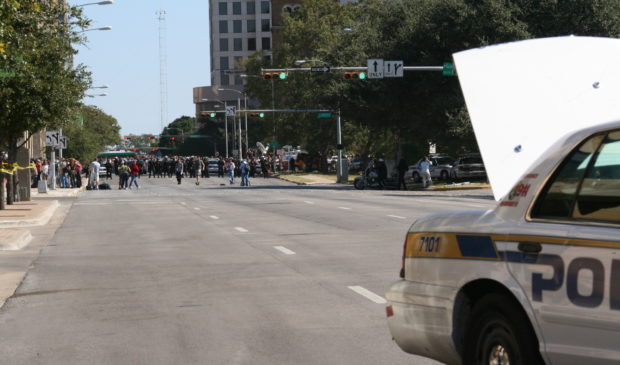Review commission works through reforms of police procedures
Wednesday, March 10, 2021 by
Sean Saldaña Last summer, amid widespread calls for police reform, Austin City Council adopted Resolution 95, which is aimed at reworking many of the Austin Police Department’s most controversial policies.
The resolution ordered APD to implement restrictions on chokeholds, purchases of military equipment, the use of tear gas to control crowds, no-knock warrants and facial recognition technology.
Last week, Police Chief Brian Manley and other APD officials presented internal policy changes related to the resolution to the Community Police Review Commission.
One of the initial items addressed at the meeting was the ban on chokeholds. According to Manley, unrelated to the City Council resolution, chokeholds have not been “approved technique for decades” and are rarely implemented by police officers. Nobody with APD or any of the commissioners at the meeting was able to accurately recall a time when a city police officer had used a lethal chokehold.
Commissioner Sukyi McMahon, who also serves as the criminal justice policy director for the Austin Justice Coalition, said, “I’m thinking to the use of force reports that we’ve seen and deaths involving police officers. I don’t recall ever seeing an officer-involved death involving a chokehold in Austin.”
Manley also talked about APD’s involvement with the 1033 Program, a Department of Defense initiative started in the late ’90s that transfers surplus military equipment to local police departments across the country.
According to Assistant Chief of Police Joseph Chacon, APD has received some large items like helicopters under the program as well as many smaller, more innocuous items like flashlights, storage containers and goggles.
APD also addressed one of the prevailing issues that gained national notoriety with the police killing of Breonna Taylor in Louisville, Kentucky: no-knock search warrants. Austin PD is now allowing no-knock entry into homes only if officer safety becomes an issue.
Manley said if law enforcement officers believe that “by announcing (their) presence and trying to obtain voluntary entry into the structure prior to a forceful entry, that there’s a likelihood that the contraband would be destroyed or flushed or whatever, that is not a satisfactory reason to go with a no-knock search warrant.”
He also clarified that approval for no-knock searches will come from the commander level, meaning that officers, sergeants and lieutenants wouldn’t be able to make a final decision.
One area that APD did push back on was the use of tear gas. According to the resolution, “it is the stated policy of the city that police use of tear gas is strictly prohibited.”
According to Manley, there are situations where tear gas is the safest tool available. Specifically, he singled out the Austin SWAT team, which is “regularly involved in hostage, rescues, barricaded subjects, officer rescues, things like that …. (Tear gas) allows you to create an environment inside a structure that is uninhabitable.”
In response to the use of tear gas during protests last summer, Manley said tear gas would only be used in crowd control to mitigate widespread property destruction, looting and vandalism – not to disperse protesters.
Although the delineation seemed helpful, there’s still some gray area in the language. Commissioner Joāo Paulo Connolly sought clarification about the changes, wanting APD to specify how protests were handled this last summer and how the department will handle future protests using these recommendations.
Due to the unpredictable nature of protest, crowd control and escalation, it was difficult for APD to outline specific guidelines for when officers would use tear gas. In general, the decision appears to rely heavily on the judgment of specialized units on the ground as large public demonstrations unfold.
According to Chacon, patrol officers aren’t regularly trained on APD protocol, though “special response teams have biannual refreshers.”
Photo made available through a Creative Commons license.
The Austin Monitor’s work is made possible by donations from the community. Though our reporting covers donors from time to time, we are careful to keep business and editorial efforts separate while maintaining transparency. A complete list of donors is available here, and our code of ethics is explained here.
You're a community leader
And we’re honored you look to us for serious, in-depth news. You know a strong community needs local and dedicated watchdog reporting. We’re here for you and that won’t change. Now will you take the powerful next step and support our nonprofit news organization?






